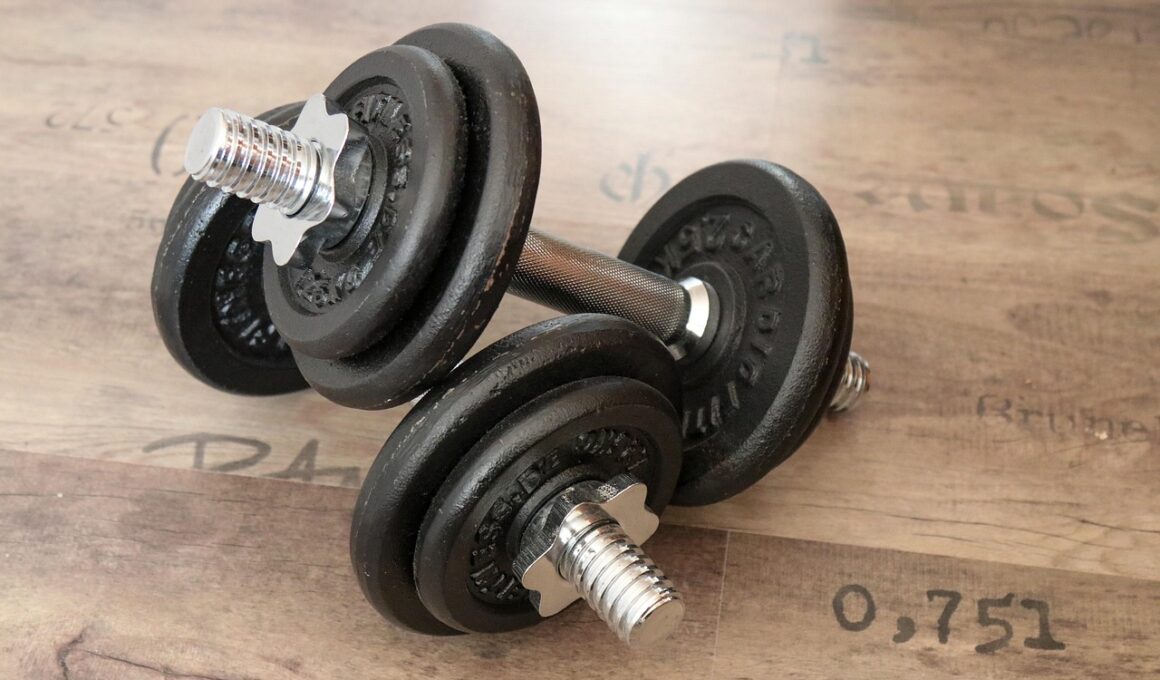How Overtraining Can Lead to Injuries in Bodybuilding Competitions
Overtraining is a significant concern for many athletes, particularly in the highly competitive world of bodybuilding. When a bodybuilder pushes their limits without adequate recovery, the risk of injury increases substantially. Symptoms of overtraining include fatigue, decreased performance, and mood swings, hinting that the body requires rest. Bodybuilders often exhibit a tendency to train intensely, neglecting the signals from their body. The result can lead to chronic injuries that hinder progress and development. Common injuries among overtrained bodybuilders encompass tendonitis, muscle strains, and stress fractures. To avoid injuries, it is crucial to balance intense workout sessions with appropriate rest periods. Incorporating lighter training days can also help in recovery. Nutrition plays a vital role in this balance, providing the necessary fuel for recovery. Hydration is equally important, as dehydration can further exacerbate fatigue and performance decline. Establishing a training schedule that allows for rest is also essential in preventing overtraining injuries. Understanding your body’s signals is pivotal in a bodybuilder’s journey toward competition. Adapting training to these signals can mitigate the risk of injuries significantly.
Proper warm-up and cool-down routines are foundational elements that bodybuilders often overlook. Engaging in dynamic stretching during warm-ups prepares the muscles for the workout ahead while reducing injury risk. Additionally, static stretching during cool-down helps enhance flexibility and facilitates recovery. A specific focus on these routines can greatly aid in injury prevention, especially after rigorous training. Bodybuilders should also pay attention to form during lifts and exercises. Poor technique can contribute to various injuries and hinder overall performance. Utilizing a trainer or attending workshops can be beneficial for maintaining proper technique. Rotating exercises is another effective strategy for avoiding overuse injuries. By changing the muscle groups targeted in workouts, bodybuilders can reduce the strain on specific areas, allowing others time to recover. Additionally, ensuring adequate sleep is vital; it is during deep sleep that the body undergoes recovery processes. Sleep impacts overall health, muscle repair, and growth hormone production. Neglecting this aspect can lead to chronic fatigue and heighten injury risks. Therefore, creating a holistic bodybuilding approach that addresses nutrition, training methods, and recovery is essential for optimal performance.
Recognizing Signs of Overtraining
Recognizing the subtle signs of overtraining is critical for bodybuilders aiming to compete. Monitoring mood, performance, and physical symptoms can signal when to adjust training intensity. Sudden drops in performance or increases in perceived exertion levels are strong indicators of fatigue. Increased irritability and mood fluctuations often accompany these physical symptoms. Learning how to distinguish these signs empowers bodybuilders to make timely adjustments to their training. Keeping a detailed training log can assist in recognizing patterns and signs of overtraining as well. Awareness of personal limits is also crucial in preventing injuries. Acknowledging when the body is not responding optimally can lead to more effective training adjustments. Furthermore, engaging in cross-training activities can provide physical benefits while taking pressure off commonly stressed muscles. Introducing aerobic exercises like swimming or cycling can significantly contribute to overall conditioning without the wear and tear of heavy lifting. Additionally, supplementing with vitamins and minerals, particularly magnesium and omega-3 fatty acids, supports reduced inflammation and muscle recovery. Recognizing the signs of overtraining should be a fundamental aspect of a bodybuilder’s training philosophy to achieve longevity and well-being in their careers.
Consulting with health professionals, including physiotherapists and sports doctors, can provide invaluable insights into injury prevention strategies. These practitioners can conduct assessments and identify potential risks early on, allowing for timely intervention if needed. Moreover, they can tailor rehabilitation programs aimed at addressing specific weaknesses or imbalances. Bodybuilders may also explore alternative recovery therapies, such as acupuncture or massage, which can offer beneficial outcomes. Regular massage therapy promotes blood flow to muscles and helps in ridding the body of lactic acid buildup. Understanding the fundamentals of injury prevention will enhance overall performance and career longevity. Additionally, maintaining open communication within training groups can contribute greatly to mutual support and injury risk awareness. Sharing experiences and tips among fellow bodybuilders can lead to collective growth and learning. Establishing a culture of injury awareness within bodybuilding can revolutionize how athletes approach training and competition. Balancing ambition with caution allows bodybuilders to pursue their goals without sacrificing their health. Ultimately, promoting a long-term vision of fitness in bodybuilding competitions enhances not just individual performance but builds a vibrant and supportive community.
Nutritional Strategies for Prevention
Nutritional strategies play a significant role in injury prevention in bodybuilding. Fueling the body with the right nutrients before and after workouts ensures optimal recovery. Protein intake, in particular, is crucial for muscle repair and growth. Including lean sources such as chicken, fish, and legumes in meals can effectively promote muscle recovery post-exercise. In addition to protein, complex carbohydrates provide energy for rigorous workouts. Foods like whole grains, fruits, and vegetables must be incorporated for balanced nutrition. Hydration, while often overlooked, is equally critical in injury prevention. Bodybuilders should ensure they consume sufficient water before, during, and after training sessions. Electrolytes can be replenished with specific drinks, particularly after intense workouts. Furthermore, timing food intake concerning training can optimize performance and recovery. Consuming a balanced meal 1-2 hours before workouts can fuel bodybuilders adequately. Similarly, refueling within the first 30 minutes post-workout can enhance recovery significantly. Understanding these nutritional priorities can empower bodybuilders to make informed choices, enhancing both training effectiveness and health. Incorporating these simple adjustments can make a noticeable difference.
Cross-training activities can serve as a vital component in reducing the risk of overtraining injuries among bodybuilders. By engaging in practices such as swimming, cycling, or yoga, bodybuilders can achieve balanced fitness while permitting recovery time for specific muscle groups. These activities provide cardiovascular benefits, increase endurance, and enhance flexibility without the straining effects of weightlifting. Incorporating variety into the routine also keeps training fresh and fascinating, presenting opportunities to learn new skills. Mental fatigue is also linked to physical injuries; hence, cross-training can offer a needed mental break from the intensity of bodybuilding. Athletes can refresh their motivation and focus, ultimately enhancing overall performance. Additionally, participating in group classes or sessions can provide a sense of community and support among trainers and athletes. This collaborative environment fosters accountability while enabling bodybuilders to push their limits safely. It is crucial to note that implementing new activities should be gradual and carefully monitored. Sudden shifts in training intensity can lead to injuries, further emphasizing the importance of listening to one’s body. Adopting cross-training strategies effectively broadens bodybuilding ambitions while safeguarding against injury risks and overtraining conditions.
Long-Term Approach to Injury Prevention
Adopting a long-term approach to injury prevention is essential in bodybuilding, particularly for those pursuing competitive excellence. Establishing a solid foundation with gradual progression is vital in any training regimen. By emphasizing quality over quantity, athletes can build strength and endurance adequately without overexerting themselves. A well-planned periodization will help in scheduling training intensities and volumes appropriately. This systematic training approach allows bodybuilders to peak for competitions while subsequently incorporating rest periods. Slow and steady adjustments in resistance training loads can foster sustainable progress over time, minimizing injury risks. Bodybuilders should also prioritize listening to their bodies, acknowledging when to push harder and when to rest. Complacency in training fatigue can cause prolonged impairments that detract from performance. Furthermore, continually educating oneself about injury prevention, recovery techniques, and body mechanics is vital. Bodybuilding is an evolving field, and staying informed through research and expert consultations can keep athletes injury-free. Ultimately, embracing a comprehensive injury prevention strategy will cultivate a healthier bodybuilding experience, rewarding athletes both physically and mentally. A sustained commitment to health now paves the path for injury-free competition years ahead in bodybuilding.
.
.


